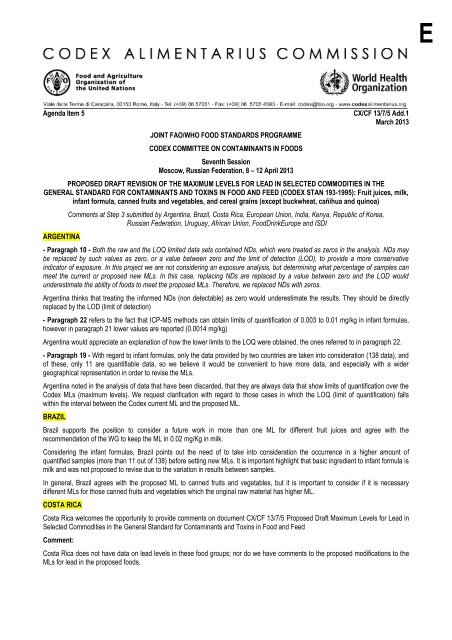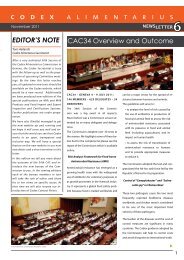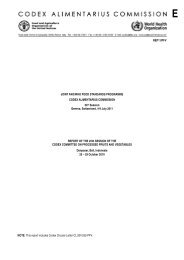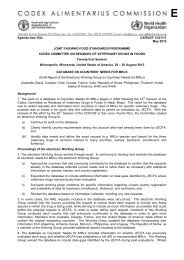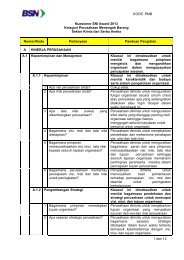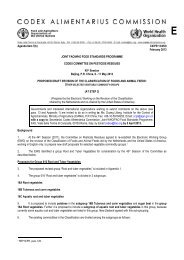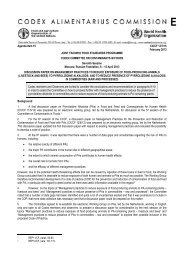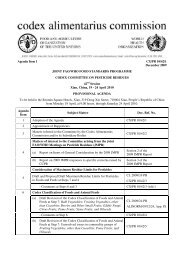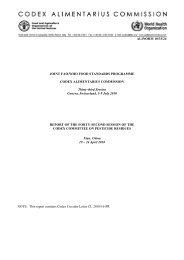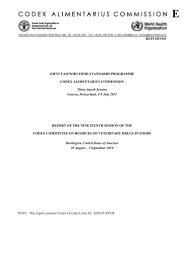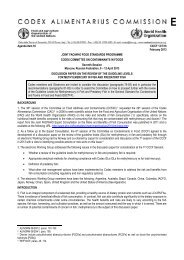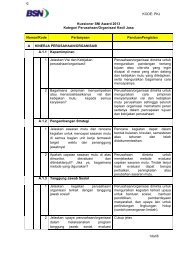CX/CF 13/7/5 Add.1 - FAO.org
CX/CF 13/7/5 Add.1 - FAO.org
CX/CF 13/7/5 Add.1 - FAO.org
- No tags were found...
You also want an ePaper? Increase the reach of your titles
YUMPU automatically turns print PDFs into web optimized ePapers that Google loves.
EAgenda Item 5JOINT <strong>FAO</strong>/WHO FOOD STANDARDS PROGRAMMECODEX COMMITTEE ON CONTAMINANTS IN FOODSSeventh SessionMoscow, Russian Federation, 8 – 12 April 20<strong>13</strong><strong>CX</strong>/<strong>CF</strong> <strong>13</strong>/7/5 <strong>Add.1</strong>March 20<strong>13</strong>PROPOSED DRAFT REVISION OF THE MAXIMUM LEVELS FOR LEAD IN SELECTED COMMODITIES IN THEGENERAL STANDARD FOR CONTAMINANTS AND TOXINS IN FOOD AND FEED (CODEX STAN 193-1995): Fruit juices, milk,infant formula, canned fruits and vegetables, and cereal grains (except buckwheat, cañihua and quinoa)ARGENTINAComments at Step 3 submitted by Argentina, Brazil, Costa Rica, European Union, India, Kenya, Republic of Korea,Russian Federation, Uruguay, African Union, FoodDrinkEurope and ISDI- Paragraph 10 - Both the raw and the LOQ limited data sets contained NDs, which were treated as zeros in the analysis. NDs maybe replaced by such values as zero, or a value between zero and the limit of detection (LOD), to provide a more conservativeindicator of exposure. In this project we are not considering an exposure analysis, but determining what percentage of samples canmeet the current or proposed new MLs. In this case, replacing NDs are replaced by a value between zero and the LOD wouldunderestimate the ability of foods to meet the proposed MLs. Therefore, we replaced NDs with zeros.Argentina thinks that treating the informed NDs (non detectable) as zero would underestimate the results. They should be directlyreplaced by the LOD (limit of detection)- Paragraph 22 refers to the fact that ICP-MS methods can obtain limits of quantification of 0.003 to 0.01 mg/kg in infant formulas,however in paragraph 21 lower values are reported (0.0014 mg/kg)Argentina would appreciate an explanation of how the lower limits to the LOQ were obtained, the ones referred to in paragraph 22.- Paragraph 19 - With regard to infant formulas, only the data provided by two countries are taken into consideration (<strong>13</strong>8 data), andof these, only 11 are quantifiable data, so we believe it would be convenient to have more data, and especially with a widergeographical representation in order to revise the MLs.Argentina noted in the analysis of data that have been discarded, that they are always data that show limits of quantification over theCodex MLs (maximum levels). We request clarification with regard to those cases in which the LOQ (limit of quantification) fallswithin the interval between the Codex current ML and the proposed ML.BRAZILBrazil supports the position to consider a future work in more than one ML for different fruit juices and agree with therecommendation of the WG to keep the ML in 0.02 mg/Kg in milk.Considering the infant formulas, Brazil points out the need of to take into consideration the occurrence in a higher amount ofquantified samples (more than 11 out of <strong>13</strong>8) before setting new MLs. It is important highlight that basic ingredient to infant formula ismilk and was not proposed to revise due to the variation in results between samples.In general, Brazil agrees with the proposed ML to canned fruits and vegetables, but it is important to consider if it is necessarydifferent MLs for those canned fruits and vegetables which the original raw material has higher ML.COSTA RICACosta Rica welcomes the opportunity to provide comments on document <strong>CX</strong>/<strong>CF</strong> <strong>13</strong>/7/5 Proposed Draft Maximum Levels for Lead inSelected Commodities in the General Standard for Contaminants and Toxins in Food and FeedComment:Costa Rica does not have data on lead levels in these food groups; nor do we have comments to the proposed modifications to theMLs for lead in the proposed foods.
<strong>CX</strong>/<strong>CF</strong> <strong>13</strong>/7/5 <strong>Add.1</strong> 3REPUBLIC OF KOREAThe Republic of Korea supports the proposed draft maximum levels for lead.RUSSIAN FEDERATIONPosition:Sharing the concern of the toxic effect of lead on the population (especially for children), we suggest it is necessary to continue workto obtain more complete data of the lead content in these foods taking into account the data from Russian Federation.Rational:We consider the revised data for ML of lead content in some foods are more strict and their adoption is to be premature.URUGUAYUruguay is grateful to have the opportunity to present these comments on document <strong>CX</strong>/<strong>CF</strong> <strong>13</strong>/7/5: Proposed Draft Revision of theMaximum Levels for Lead in selected Commodities in the General Standard for Contaminants and Toxins in Food and Feed(CODEX STAN 193-1995): fruit juices, milk, infant formula, canned fruits and vegetables and cereal grains (except buckwheat,cañihua and quinoa) (at Step 3).Paragraph 35.Concerning the recommendations in the document, Uruguay has the following comments-Recommendation 1 - Although our ruling establishes 0.05 mg/kg, according to data collected from local products and by themethodology used, we have no problem with lowering the value to 0.03 mg/kg.Recommendation 4 - We have no objections to this recommendation.Recommendations 2, 3 & 5 - We have no comments on these.AFRICAN UNIONAfrican Union DOES NOT support theproposed lowering of MLS for lead by twofolds in fruits juice (from 0.05mg/kg to0.025mg/kg) and infant formula 0.02mg/kgto 0.01mg/kg) and by ten folds for cannedfruits (1.0mg/kg to 0.1mg/kg) andvegetables (1.0mg/kg to 0.1mg/kg).However, we AGREE that the current MLsfor milk (0.02mg/kg) and cereals (0.2mg/kg)be maintained.Although African Union DOES NOTsupport the proposed lowering of the ML forinfant formula, we do support therecommendation to add a note in thenote/remarks column in the GSCTFF thatthe ML of 0.02mg/kg also applies topowdered formula with a dilution factor.The reason for establishing MLs is to protect the health of the consumer worldwide,in this case from lead which has been associated with a wide range of adversehealth effects including various neurodevelopmental effects, impaired renal function,hypertension, impaired fertility and adverse pregnancy outcomes. Due to theneurodevelopmental effects, foetuses, infants and children are the most vulnerableto lead. However, when data used to revise MLs have narrow geographicalrepresentation then the objective of setting world standards is defected. The MLs forfruits juice, infant formula, and canned fruits and vegetable were revised withoutconsideration of lead contamination status in Africa.Mali was the only African country that contributed 99 of the 9080 results analysed toreach the decision to uphold the current MLs for cereals. This makes the decisioncredible with regards to geographical representation and so gains our support.The absolute lack of data from the continent on levels of lead in milk, fruits juice,canned fruits and vegetables underscores the need for Africa to support researchesat regional laboratories that would generate valid data that will meet worldstandards.The footnote is necessary to address situation where infant formula is marketed inliquid form (ready-to-eat)FOODDRINKEUROPEFRUIT JUICE (§12-15) 1There is a general concern with lead maximum limits set below 0.05 mg/kg for fruit juices. Using methods of analysis with a lowerLOQ of 0.01 mg/kg is achievable globally but not always current practice. Many existing standard laboratory methods have an LOQof 0.05 mg/kg for commodities such as fruit juice, concentrate and purees due to EU limits for fruit juices being set to 0.05 mg/kg.Applying another method with a lower LOQ (down to 0.01 mg/kg) would result in a financial impact where there are no safetyconcerns with the current higher 0.05 mg/kg maximum limit.1It is our understanding the current proposal applies not only to fruit juices and nectars but also to reconstituted juices, purees and concentratedpurees.
<strong>CX</strong>/<strong>CF</strong> <strong>13</strong>/7/5 <strong>Add.1</strong> 4There is further concern over berry fruit juices. Generalising all juices together is not a scientific approach as there are differences inlead levels present among the various juices. The assumption is that one would be able to apply concentration factors forconcentrated juices. However, a concern regarding the limit of 0.03 mg/kg for berry juices still exists. A higher limit should beproposed for these. In EC reg. 1881/2006 there is a higher limit for lead in berries and small fruit (0,20 mg/kg), by comparison to fruitin general (0,10 mg/kg), recognising that the former types of fruits are more prone to present higher concentrations of lead (largersurface compared to fruit weight). A more reliable update from a relevant sector group (more data on concentration factors) could bemade.’It is also worth noting that the fruit juices ML appears to have had limited geographic sampling as many South American marketshave not been incorporated into the assessment.§ 15: We believe that, in addition to cherry juices, that the scope of this point be extended to include all small fruit and berry juices,which need a higher ML, or of at least.05 mg/kg. The European producers of fruit juices and nectars are in favour of maintaining thecurrent ML of 0.05 mg/kg, and would like to put forward the following arguments:ooo§ 14: The suggested reductions in the document prepared by the eWG are not consistent for all the food groupsassessed: the basis to decide that eliminating 4% of the international trade of fruit juices could be acceptable forproducers is not clear;§ 12: It is arguable whether decreasing maximum levels simply considering what is achievable according to theGEMS database and disregarding which foods contribute most to lead exposure is the best approach;§ 4: The per capita consumption of fruit juices in Europe is set at ca 21 litres (58 ml/day). Surveys show that dietarylead exposure has been decreasing over the years. Fruit juices contribute a small percentage to lead exposure.§ 15: In the event that the current ML of 0.05 mg/kg cannot be maintained, we would like to suggest a split level between:ooBig fruits – for which
<strong>CX</strong>/<strong>CF</strong> <strong>13</strong>/7/5 <strong>Add.1</strong> 5§ 32: While JE<strong>CF</strong>A has not been able to establish a safe limit for lead, the proposed revision of the lead limit for infant formula doesnot provide any evidence that the current ML for lead in infant formula is unsafe, nor does it provide evidence that the proposed MLincreases safety of infant formula.Furthermore JE<strong>CF</strong>A withdrew its previous provisional tolerable weekly intake (see JE<strong>CF</strong>A evaluation, WHO technical report series960) due to a wide range of effects linked to the exposure to lead. We are aware of the wide range of effects, including variousneurodevelopmental effects, which make fetuses, infants and children the most sensitive subgroups to lead. Due to the above, wewould agree with revisiting the MLs for lead in various food stuffs.According to a survey conducted by the World Health Organization in 1989, human breast milk concentrations of lead range fromless than 0.001 ppm to 0.219 ppm, and more recent publications have also demonstrated that the concentrations of lead in breastmilk have regional differences which often exceed the existing limit. Due to these large regional differences in lead concentrations inhuman breast milk, it is likely that regional variations in lead concentrations in the environment produce a much larger difference inrisk than the proposed change in the ML for lead in infant formula (0.02 to 0.01 ppm) would create.CANNED FRUIT AND VEGETABLE (§ 25 - 29)§ 25-28: The level of 0.1mg/kg proposed by Codex for canned fruit and vegetables is appropriate. We however do find that furtherdata collection is necessaryCEREALS (§ 30 - 31)§ 31: We agree that the current ML 0.2mg/kg for all cereals is appropriateALLAlthough FoodDrinkEurope data was not taken into account, results would not have been noticeable altered. FoodDrinkEuropeappreciates a possible opportunity to contribute data, which has been collected, on lead in fruit juices, next year.When defining new MLs for lead in various foodstuffs,ISDI§ 9: An exposure analysis should also be carried out (which is not the case in this document).§ 14 & 27 respectively. A consistent approach should be followed in defining which% of samples should be eliminated frominternational trade (e.g. why 4% for fruit juices and 2% for canned fruits?)§ 31. Agreed. A need to update the proposed revised MLs for re-consideration next year.The International Special Dietary Foods Industries (ISDI) represents at Codex Alimentarius the associations of manufacturers ofspecial dietary foods and hence is highly involved and interested in contributing to any work that will relate to nutrition products.ISDI supports keeping the current Codex ML of 0.02 mg/kg for lead in infant formula. We do not support lowering the ML to0.01 mg/kg because there is no scientific justification for making this change.The eWG recommendation to lower the ML for lead in infant formula from 0.02 mg/kg to 0.01 mg/kg was based on data from theJoint <strong>FAO</strong>/WHO Joint Expert Committee on Food Additive’s (JE<strong>CF</strong>A) Global Environment Monitoring System – Food ContaminationMonitoring and Assessment Programme (GEMS/Food). The GEMS/Food database provides evidence of what the lead levels are ininfant formula, but does not assess the health or safety aspects of these levels. JE<strong>CF</strong>A has not established a safe level for lead, andthe CC<strong>CF</strong> document does not provide any evidence that the current ML for lead in infant formula is unsafe. Lowering the Codex MLbecause the infant formula samples in the GEMS database contained lower levels is not a scientific justification for such action,Further, the document provides no evidence that the proposed lower ML would increase the safety of infant formula.According to a 1989 World Health Organization survey, lead concentrations in human breast milk ranged from 0.001 to 0.219 mg/kg,and more recent publications have demonstrated that lead concentrations vary by region and many exceed the current Codex ML.Due to this broad range of lead concentrations among regions, it is likely that regional variations in lead concentrations in theenvironment produce a larger difference in risk than the proposed change in the ML for lead in infant formula (e.g., 0.02 to0.01 mg/kg) would create. In addition, the dataset that this recommendation is based on is very narrow, with nearly all samplestested coming from a couple different regions, so there may be some countries where the lower ML does cause an issue.It has been discussed that a separate ML for lead in follow-up formula (FUF) may be explored. However, due to the variation in thedefinition for FUF between countries, it would be challenging to develop a single ML for the entire product category that would fit arisk assessment that covers the global population for this category. Therefore, we recommend against establishing a separate ML forlead in FUF.Finally, the GEMS/Food database contained data only on ready-to-feed liquid infant formulas. If the ML for lead in infant formula islowered, we recommend language be added to indicate the ML is intended for infant formula “as consumed.”


